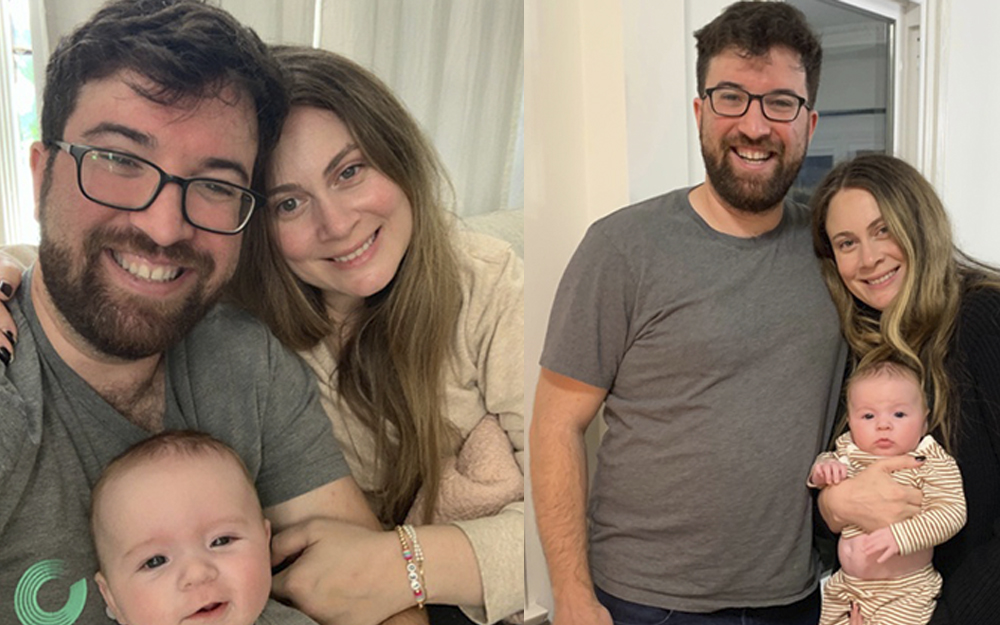New Mom With Two Blocked Arteries Gets a Second Chance at Life
Date
February 10, 2022

Date
February 10, 2022
Credits
Medical providers featured in this article
In Brief
{{cta-block}}
When 32-year-old Danielle Renan became pregnant in January 2021, she experienced morning sickness during the first trimester and high blood pressure. She took baby aspirin during pregnancy, and when she delivered her son, Leo, on September 16, the experience was seamless, quick and easy.
"I pushed for 10 minutes," says Danielle. "My mom filmed the birth and there was a moment where I looked at the camera and said, 'This doesn't hurt at all.' It was the best birth story ever."
A few days later, however, disorientation, confusion and frustration set in when Danielle turned to her husband, Mikey Renan, and couldn't complete a sentence or answer a simple question. What followed was a terrifying health ordeal that took her from the best birth story ever, to the operating room for complex neurosurgery.
"I was stressed, exhausted and I just felt off, like my brain wasn't working," Danielle says. "Mikey asked me when our son was born, and I couldn't answer him."
Disorienting symptoms
Just two days after Danielle came home from Cedars-Sinai with baby Leo, she checked her blood pressure during a feeding and discovered it was high. She began feeling lightheaded and off balance. She had an odd sensation across her jaw and neck, like a lump in her throat, but different.
"I was stressed, exhausted and I just felt off, like my brain wasn't working," Danielle says. "Mikey asked me when our son was born, and I couldn't answer him." The couple tried to make sense of her nonsensical symptoms, ultimately returning to Labor and Delivery where doctors diagnosed her with preeclampsia.
But Danielle's concerning symptoms didn't ease. She developed occasional numbness in her tongue and left arm, and she could hear the sound of her heartbeat swishing in her right ear. She also began experiencing intermittent paralysis on her right side. And her blood pressure continued climbing, hovering around 170/100.
Doctors at Cedars-Sinai treated Danielle with high blood pressure medications and a 24-hour magnesium drip. Her blood pressure stabilized, and she went home on high-dose blood pressure medications. But the respite was short-lived. The numbness came back.
One evening she went to the front door to get a delivery and her right arm and leg went limp. For a few days in a row, there were moments when the right side of her body went numb.
Over the next 10 days, Danielle's obstetrician and every member of her care team struggled to identify the source of her new and concerning symptoms. "More than once, I went to the hospital in the middle of the night for a severe headache. I knew something was wrong, but no one could make sense of my symptoms." Throughout, she kept advocating for herself and pushing for answers.
In the Newsroom: Heart Surgery, Followed by Childbirth
The moment of truth

Then one morning in late September, paralysis overtook the right side of her body and she couldn't speak at all. Mikey called an ambulance and Danielle was admitted at Cedars-Sinai.
Teams of doctors from different specialties, including obstetrics, neurology, radiology and cardiology were called to consult on Danielle's case, and she continued having terrifying episodes where she couldn't speak.
"I knew what I wanted to say, but I couldn't make myself say it," she says.
An MRI turned up nothing. On imaging scans, her brain appeared fine. "But over the next 24 hours, the episodes started getting longer and I couldn't move the right side of my body," Danielle says. "Within a couple of days, doctors figured out that if I stayed in a horizontal position and kept my blood pressure within a specific range, I wouldn't have an episode."
The reason it took so long to identify the issue: Danielle's condition, especially for a new mom, was extremely rare: She had tears, or dissections, in both of her carotid arteries that were dramatically reducing blood flow to the brain. Both arteries were more than 90% blocked.
"The carotid artery is usually the size of your finger—Danielle's left artery was narrowed down to a thread," says her surgeon Dr. Michael J. Alexander, vice-chair of Neurosurgery at Cedars-Sinai and a neurovascular surgery expert.
That narrowing produced these intermittent ministrokes, called transient ischemic attacks (TIAs). The standard treatment for dissections is a blood thinner, but Danielle was suffering from TIAs even with medical therapy, so she was failing conventional medical therapy.
"When the artery is that narrow, and patients are failing medical therapy, the best treatment is stenting to open the artery," Dr. Alexander says. "The stents are about the size of your little finger, and they open up the artery so blood can flow freely to the brain."
Renewed strength
While Danielle was in the hospital, family arrived from near and far to take care of her newborn baby. She used video calls to see Leo and even virtually attend his first pediatrician appointment.
For the procedure, Dr. Alexander inserted a small tube into her artery, opening up the blockage with a balloon. "Once the artery is open, we insert the stent, which is this flexible mesh tube that's also self-expanding," Dr. Alexander says. "The tube is only the size of spaghetti, but when the stent comes out of that tube, it opens up and expands to the shape of the artery, then heals into the artery wall."
Unfortunately, while doctors were repairing Danielle's left artery, which was 99% blocked, they saw blood leaking out of her right carotid artery as well. "Just having one arterial dissection around pregnancy is rare, but to have both arteries affected is almost unheard of," Dr. Alexander says. "In 20 years of practice, I've never seen it before."
By the time Danielle was released from the hospital, Leo was 3 weeks old.
In Discoveries: Stroke Safety
"My mind was in survival mode," Danielle says. She no longer had trouble speaking or staying on her feet. But she remained on high alert, suffering from anxiety.
Without hospital safeguards and nurses waking her up every hour to ensure she could speak coherently, she worried her arteries would fail her again and no one would know. "The further I got away from the procedure, the more those feelings started to fade," Danielle says.
Doctors still don't know why Danielle suffered from these symptoms. They don't know why her arteries tore. "I try to focus on the facts," Danielle says. "During the procedure, Dr. Alexander looked at my other arteries and they looked healthy. The surgery was a success and the affected arteries have healed. Right now, in this moment, everything is good." And just a few weeks ago, an angiogram showed her arteries have completely healed.
Leo is doing well, too. Now 4 months old, he coos, smiles and keeps Danielle and Mikey on their toes. "I know I'm lucky to be alive," Danielle says. "I won't ever take that for granted."
Stroke Basics
Stroke can happen to anyone. The sudden onset of the following symptoms could signal a stroke:
- Numbness or weakness of the face, arm or leg, particularly on one side of the body
- Confusion, trouble speaking and difficulty with word finding
- Compromised vision or dizziness
- Difficulty walking and or loss of balance or coordination
- Severe headache with no known cause
"Patients often think, I'll just sleep it off and see if it's better in the morning," Dr. Alexander says. "But symptoms of speech problems, numbness and loss of balance should be checked out immediately."





